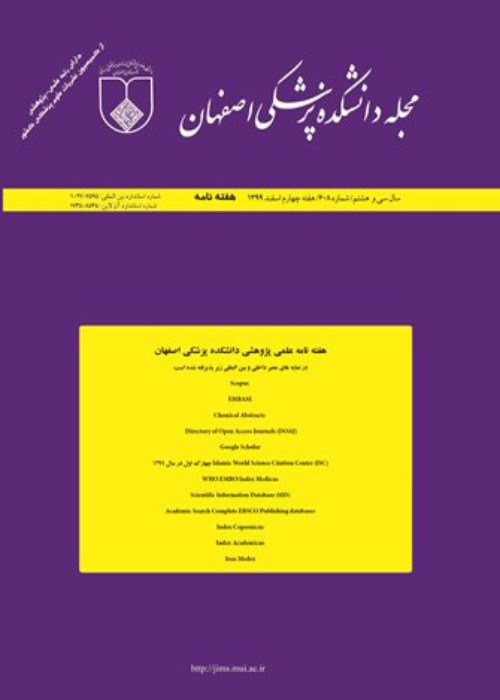فهرست مطالب

مجله دانشکده پزشکی اصفهان
پیاپی 747 (هفته سوم بهمن 1402)
- تاریخ انتشار: 1402/12/15
- تعداد عناوین: 2
-
-
صفحات 1069-1074مقدمه
یکی از مکانیسم های مهم در تخریب پیشرونده ی میلین و ایجاد ناتوانیهای عصبی آپوپتوز سلولهای الیگودندروسیتی است. مرگ سلول های الیگودندروسیتی معمولا به دلیل التهابات موضعی و اثرات سمی بعضی از عوامل محیطی ایجاد می شود. والپروییک اسید بدلیل داشتن اثرات متنوع آنتی اکسیدانی، ضد آپوپتوزی، ضد التهابی و محافظت کنندگی عصبی، قادر است باعث افزایش بقا و تمایز سلولی شود. در مطالعه ی حاضر اثرات این ترکیب در پیشگیری از مرگ سلول های الیگودندروسیتی در جسم پینه ای مغز موش مورد بررسی قرار گرفت.
روش هادر این مطالعه، تعداد 40 عدد موش سوری بصورت تصادفی در چهار گروه شاهد، شم، کاپریزون و والپروییک اسید /کاپریزون تقسیم شدند. به منظور مرگ سلول های الیگودندروسیتی از ترکیب کاپریزون 2/0 درصد استفاده شد. بعلاوه ترکیب والپروییک اسید بصورت داخل صفاقی، روزانه و با دوز mg/kg300 و به مدت سه هفته استفاده شد. به منظور بررسی مارکرهای ویژه سلول های الیگودندروسیتی، از روش های ایمونوهیستوشیمی و ریل تایم استفاده شد.
یافته هانتایج نشان داد که درصد سلول های بیان کننده ی مارکر (Oligodendrocyte transcription factor) Olig2 و (Myelin oligodendrocyte glycoprotein) Mog در گروه دریافت کننده ی والپروییک اسید، نسبت به گروه های دریافت کننده ی کاپریزون به شکل معنی داری افزایش پیدا کرده است (0/05 > P). همچنین، افزایش بیان ژن های ویژه ی سلول های الیگودندروسیتی در روش Real Time-PCR گزارش شد.
نتیجه گیرینتایج این مطالعه نشان داد که والپروییک اسید، توانایی پیشگیری از مرگ سلول های الیگودندروسیتی را دارد و لذا استفاده از این ترکیب می تواند راهکاری مناسب، برای پیشگیری از تخریب میلین در بافت عصبی باشد.
کلیدواژگان: والپروئیک اسید، الیگودندروگلیا، فاکتور 2 رونویسی الیگودندروسیتی، گلیکوپروتئین میلین-الیگودندروسیت -
صفحات 1075-1079مقدمه
شناسایی عوامل موثر در پیشرفت اسیدوز لاکتیک و احتمال مرگ در درمان بیماران مسموم شده با متفورمین امری ضروری است. این مطالعه به بررسی سطوح لاکتات خون در بیماران مسموم با متفورمین و فاکتورهای موثر بر آن می پردازد.
روش هااین مطالعه گزارش بیماران است که در دو مرکز سم شناسی بالینی در ایران به مدت یک سال انجام شد. 16 بیمار در این مطالعه وارد شدند. پرسش نامه بر اساس مشخصات دموگرافیک فرد، علایم حیاتی، علایم مسمومیت، بیوشیمی خون، گازهای خون، قند خون و درمان تکمیل شد. سطح لاکتات 6-12-24 ساعت بعد شروع درمان اندازه گیری شد.
یافته ها3 نفر از بیماران (18/8 درصد) مرد و 13 نفر (81/3 درصد) زن بودند. میانگین سنی افراد 16/22 ± 30/13 سال بود. یک مورد هیپوگلیسمی، 3 مورد اسیدوز متابولیک و 3 مورد سطح کراتینین بالای 1/2 در بین بیماران مشاهده شد. سطح pH و بی کربنات بدو ورود، پیش بینی کننده های سطح لاکتات بودند. هیچ موردی از مرگ یا اسیدوز لاکتیک مشاهده نشد.
نتیجه گیریسطح pH و بی کربنات خون می توانند به عنوان پیش بینی کننده های افزایش لاکتات سرم استفاده شوند. همچنین یافته های این مطالعه نشان داد که احتمال مرگ و اسیدوز لاکتیک با متفورمین بسیار کم است.
کلیدواژگان: مسمومیت، لاکتیک اسید، اسیدوز لاکتیک، متفورمین
-
Pages 1069-1074Background
Oligodendrocyte apoptosis is one of the principal mechanisms in progressive myelin destruction and the development of neurological disabilities. The oligodendrocyte cell death is usually caused by local inflammation and the toxic effects of some environmental factors. Valproic acid can increase cell survival and differentiation due to its diverse antioxidant, anti-apoptotic, anti-inflammatory, and neuroprotective effects. In the present study, the effects of this compound were investigated in preventing oligodendrocyte cell death in the mouse brain corpus callosum.
MethodsIn this study, 40 mice were randomly divided into four groups: control, sham, cuprizone, and valproic acid/cuprizone. To kill oligodendrocyte cells, 0.2% caprizone compound was used. In addition, the combination of valproic acid was used intraperitoneally, daily with a dose of 300 mg/kg, and for three weeks. immunohistochemical and real-time methods were used to investigate the specific markers of oligodendrocyte cells.
FindingsThe results showed that the percentage of cells expressing Oligodendrocyte transcription factor (Olig2) and Myelin oligodendrocyte glycoprotein (Mog) markers increased significantly in the group that received valproic acid compared to the groups that received cuprisone (P < 0.05). Also, an increase in the expression of oligodendrocytes-specific genes was reported in the Real Time-PCR method.
ConclusionThe results of this study showed that valproic acid can prevent oligodendrocyte cell death, therefore, the use of this compound can be a suitable solution to prevent the destruction of myelin in nerve tissue
Keywords: Valproic acid, Oligodendroglia, Oligodendrocyte Transcription Factor 2, Myelin-Oligodendrocyte Glycoprotein -
Pages 1075-1079Background
Identifying the effective factors in the progression toward lactic acidosis and death is essential in improving the treatment of Metformin-poisoned patients. This study investigates the blood lactate level in Metformin-poisoned patients and the factors affecting it.
MethodsThis was a case series study in two referral clinical toxicology centers in Iran for one year. 16 patients were included in the study. The questionnaire was filled out based on the demographic characteristics of the person, vital signs, poisoning symptoms, blood biochemistry, blood gases, blood sugar, and treatments. The lactate level was measured 6-12-24 hours later.
FindingsThree cases (18.8%) were male and 13 (81.3%) were female. The average age was 30.13 ± 16.22 years. One case of hypoglycemia, three cases of metabolic acidosis, and three cases of creatinine level above 1.2 were observed. The initial pH and bicarbonate were predictors of the lactate level. No cases of death or lactic acidosis were observed.
ConclusionBlood pH and bicarbonate can be used as predictors of serum lactate increase. Also, this study showed that the probability of death and lactic acidosis with metformin is very low.
Keywords: Poisoning, Lactic Acid, Lactic acidosis, Metformin

